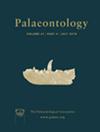以黄鼬为例,发育模型揭示了最早的牙齿组织
IF 2.3
2区 地球科学
Q1 PALEONTOLOGY
引用次数: 0
摘要
已灭绝的无颌脊椎动物化石对于解读脊椎动物骨骼各种形态的进化路径至关重要。例如,奥陶纪的翼腹目(茎侏罗纪)Astraspis就展示了一些最古老的骨骼和 "牙齿"(牙本质和珐琅质)组织遗迹。然而,由于缺乏明确的诊断特征,鉴定这些早期矿化组织的性质一直受到阻碍。由于发育是确定这些组织衍生物的关键,我们开发了一个综合的通用组织发生学模型,测试了几种本体发育情况。我们以保存完好的黄鼬样本为基础说明了我们的方法,并展示了如何利用这种方法推断已灭绝物种的关键发育特征。这项研究表明,Astraspis的齿顶组织:(1)上皮细胞的初始弧度接近最终外表面的形状;(2)间质细胞在整个内周同步分化;(3)盖层组织由间质细胞和上皮细胞(类釉质而非釉质)共同产生。黄龙鱼标本还提供了双重生长周期的证据,可能与羊膜动物中观察到的安德烈森生长线和冯-埃布纳生长线同源,这表明大多数脊椎动物可能都具有这种双重周期。据我们估计,黄颡鱼的口器以每天 0.5-5 μm 的速度生长,大约需要 60-70 天。本研究提出的新的发育方法可以成为未来严格评估已灭绝类群组织的有力框架。本文章由计算机程序翻译,如有差异,请以英文原文为准。
Developmental models shed light on the earliest dental tissues, using Astraspis as an example
Fossils of extinct jawless vertebrates are pivotal to deciphering the evolutionary paths that led to the various forms of the vertebrate skeleton. For example, Pteraspidomorphs (stem-gnathostomes), such as the Ordovician Astraspis, display some of the oldest remains of bony and ‘dental’ (dentine and enameloid) tissues. However, the identification of the very nature of these early mineralized tissues has been hampered by a lack of unambiguous diagnostic characters. As development is key to identifying the derivation of these tissues, we developed an integrative and generic histogenetic model, testing several ontogenetic scenarios. We illustrate our approach on the basis of the well-preserved Astraspis samples and show how this can be used to infer key developmental features from extinct species. This study suggests that in the odontodes of Astraspis: (1) the initial curvature of the epithelium was close to the shape of the final external surface; (2) the mesenchymal cells differentiate synchronously in the whole inner periphery; and (3) the capping tissue was produced by both mesenchymal and epithelial cells (enameloid rather than enamel). Astraspis specimens also provide evidence of a dual growth periodicity, possibly homologous to Andresen and von Ebner growth lines observed in amniotes, suggesting this type of dual periodicity may be shared by most vertebrates. We estimated that an Astraspis odontode grew up in around 60–70 days at a rate of 0.5–5 μm/day. The new developmental approach proposed in this study could be a robust framework for critically evaluating the tissues of extinct taxa in the future.
求助全文
通过发布文献求助,成功后即可免费获取论文全文。
去求助
来源期刊

Palaeontology
地学-古生物学
CiteScore
5.60
自引率
3.80%
发文量
43
审稿时长
6 months
期刊介绍:
Palaeontology publishes a wide variety of papers on palaeontological topics covering:
palaeozoology
palaeobotany
systematic studies
palaeoecology
micropalaeontology
palaeobiogeography
functional morphology
stratigraphy
taxonomy
taphonomy
palaeoenvironmental reconstruction
palaeoclimate analysis and biomineralization studies.
 求助内容:
求助内容: 应助结果提醒方式:
应助结果提醒方式:


